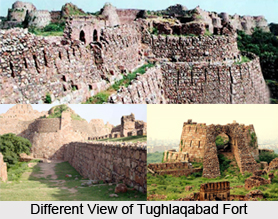 Tughlaqabad Fort is a ruined fort located in Delhi. Stretched across 6.5 km it is one of the largest forts in India. The fort has been built by Ghiyas- ud- din Tughlaq in 1321. He was the founder of Tughlaq Dynasty of the Delhi Sultanate. He had also built the fortified town of Tughluqabad, the third city of Delhi. The fort also lends its name to the Tughlaqabad residential-commercial area as well as the Tughlaqabad Institutional Area. Tughlaqabad Fort is still open for the tourists to visit. However, some of the parts remain closed and there are different remnants that can still be found in the area.
Tughlaqabad Fort is a ruined fort located in Delhi. Stretched across 6.5 km it is one of the largest forts in India. The fort has been built by Ghiyas- ud- din Tughlaq in 1321. He was the founder of Tughlaq Dynasty of the Delhi Sultanate. He had also built the fortified town of Tughluqabad, the third city of Delhi. The fort also lends its name to the Tughlaqabad residential-commercial area as well as the Tughlaqabad Institutional Area. Tughlaqabad Fort is still open for the tourists to visit. However, some of the parts remain closed and there are different remnants that can still be found in the area.
History of Tughlaqabad Fort
The Tughlaqabad fort was built Ghazi Malik. He was slave to Mubarak Khilji. Once during a walk with his Khilji master, Ghazi Malik suggested him to construct a hillock in the southern portion of Delhi. The king then joked that Malik himself should build a fort if he ever became a sultan. Malik eventually become Ghiyas-ud-din Tughlaq, the first ruler of the Tughlaq dynasty. He would then build the fort in 1321. He also drove away the Khiljis. He soon began the construction of his fabled city. The fort was however, abandoned in 1327. It is said that once Ghiyas Ud Din Tughlaq had become so obsessed with the construction of the fort that he issued an order that all labourers in Delhi must work on his fort. This affected the work of Hajrat Nizamuddin Auliya as many labourers were then engaged in building his baoli (well). The enraged saint confronted the king and cursed him. Once the emperor was occupied in a campaign in Bengal and was on his way to Delhi. Eventually, Tughlaq died when a canopy collapsed on him. His successor then abandoned the fort and built a new one.
Mausoleum of Ghiyas Ud Din Tughluq
The `Mausoleum of Ghiyath Ud Din Tughluq` is located on the south across the main entrance of Tughluqabad. The tomb can be entered by a high gateway and is made up of red sandstone. It is inlaid with inscribed panels and arch borders of marble. It also has a flight of steps. It remains connected by a causeway to the southern outpost of the fortification. The tomb of Ghiyath Ud Din Tughluq is made up of a single domed square tomb that rests on an octagonal drum and is enclosed within high walls. The walls of the tombs are surmounted by parapets. The tomb thus retains some of the characteristics of Khilji architecture.
There are three graves inside the mausoleum. The main grave belongs to Ghiyath Ud Din Tughluq and the other two are believed to be those of his wife and his son and successor Muhammad Bin Tughluq.
An inscription can be seen over its southern entrance that states the fort houses the remains of Zafar Khan. Another octagonal tomb of similar style is visible in the north-western bastion of the enclosure wall with pillared corridors.
Architecture of Tughlaqabad Fort
The Tughlaqabad Fort covers an area of about 6.5 km. It consists of massive stone fortifications and features wall that are at least ten to fifteen meters in height. The walls are surmounted by battlemented parapets and supported by circular bastions of up to two stories height. The stone fortifications enclose the ground plan of the city. The city of Tughlaqabad had been divided in two parts, the first unit is formed of the citadel and palaces along the southern walls and the other part is formed of the city to the north. The citadel as well as the walls of palaces can still be seen. The city is, however, in ruined state. Only the alignment of some of its streets can be discerned. The city walls are rubble built which is a characteristic feature of the monuments of the Tughluq Dynasty. Earlier the city had as many as 52 gates but now only 13 gates remain. The fortified city contained seven rainwater tanks. Traditional stones are used for building of the fort to make it strong and tough.
A large city spot can be seen around the gates of the Tughlaqabad Fort. There are a number of remnants of houses around the fort. However, the city remains inaccessible due to dense thorny vegetation that has grown due to the lack of use of the area. Some spots that had artificial lakes and other bodies of water can also be seen here. In these empty spots water was stored for use of people around the fort. There was a vast artificial water reservoir within the premises of the Ghiyath Ud Din Tughluq`s Tomb. It has been well maintained till date and connects the fort by an elevated causeway.
The Bijay Mandal is another famous structure located around the area. It is a towering structure has a proportioned square dome. The huge structure has been originally built by Ala-ud-din Khilji. The massive structure, octagonal in shape is located in the in the middle of a large area surrounded by a wall. It is said that Tughluq conducted the administration of his vast empire from here. According to historical records the entire structure was built gradually over a period of nearly a century, with the dome shaped building being the last addition.



















